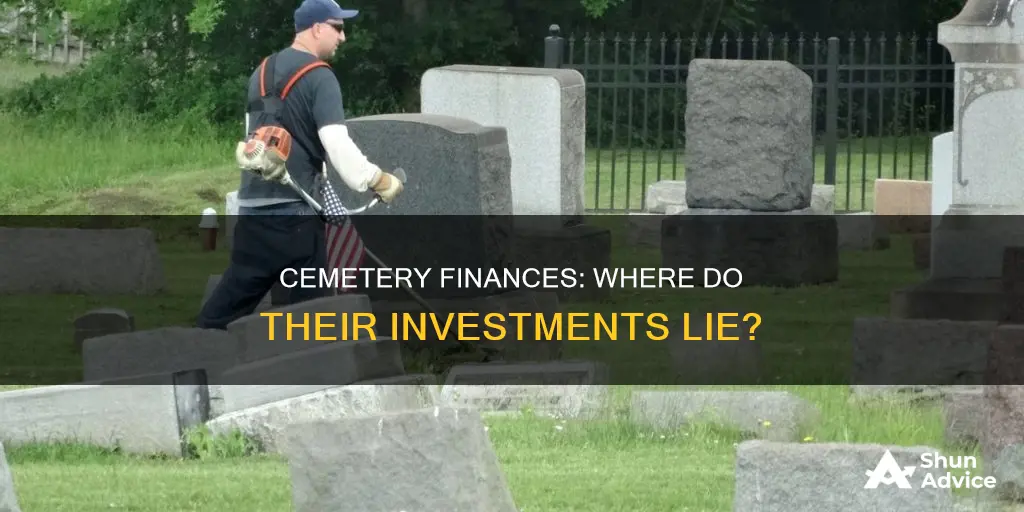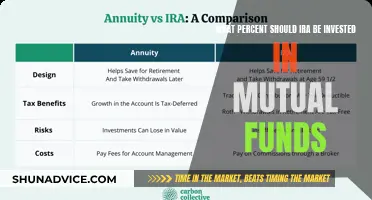
Cemeteries are businesses that need to generate revenue to cover their expenses and ensure their ongoing maintenance. While their primary purpose is to provide a dignified and peaceful resting place, they also have to make money. So, where do cemeteries invest their funds? Most cemeteries are required to put a percentage of their grave sales into a perpetual care fund during their prime operating years. This fund is meant to ensure the cemetery can continue operating and maintaining its grounds forever, or perpetually. However, saving up for eternity is no easy task, and many cemeteries underprice their plots, making up for it by charging more for auxiliary services. Additionally, cemeteries may invest in expansion by purchasing additional land to prolong their prime operating years and continue making money from grave plots.
| Characteristics | Values |
|---|---|
| Investment Type | Perpetual Care Trust |
| Investment Purpose | To fund the cemetery's maintenance and operations forever |
| Investment Vehicle | Endowment, Trust |
| Investment Amount | Varies, typically 5-15% of sales or 10% of plot sales |
| Investment Manager | Trust manager or cemetery owners |
| Investment Returns | Interest income |
| Investment Risk | Low, but risk of insufficient funding |
| Investment Time Horizon | Forever |
| Investment Regulation | State-level guidelines and regulations |
What You'll Learn

Perpetual care trusts
Perpetual care funds are important because maintenance costs are a significant portion of a cemetery's operating budget. These costs include grounds keeping, road repairs, and general upkeep of cemetery infrastructure. Without perpetual care trusts, it would be difficult for cemeteries to cover these costs from current operating revenue, especially once they have sold out and are closed to additional interments. In some cases, cemeteries have tried to bill families annually for maintenance, but this becomes impractical over time as relatives pass away or move away.
In addition, perpetual care trusts can help to assure customers that the cemetery grounds will be maintained indefinitely, which can encourage the choice of traditional interment over cremation. This is particularly important given the growing trend towards cremations and lower spending on death care services.
The funds in a perpetual care trust are managed by a third-party trustee, who is responsible for oversight of the trust and its investments. The trustee hires an accounting firm to audit the trust and provide the necessary reports and tax filings. The trustee is also required to invest and reinvest the funds in accordance with relevant laws and regulations. The cemetery company then receives the net income from the trust on a quarterly basis, which can be used to cover maintenance and upkeep costs.
Overall, perpetual care trusts play a crucial role in ensuring the long-term financial stability of cemeteries and providing peace of mind to customers.
Loaded Fee Mutual Funds: When to Invest and Why
You may want to see also

Expansion
In the case of Washington Cemetery in Brooklyn, they had already maximised their space by shrinking the parking lot, removing roads, and even converting a small lawn. With no more room to expand, they were forced to stop selling plots. However, by opening a new section in Staten Island, they were able to extend their operations by another 10 to 15 years.
Density is a key factor in cemetery expansion. For example, Woodlawn Cemetery in the Bronx was able to fit 2,500 new burial spaces, a mix of burials and cremations, on less than an acre of new space. This expansion gave them more inventory and extended their prime selling phase.
While expansion is a viable strategy, it is not without its challenges. The availability of land, zoning laws, and community opposition can hinder a cemetery's ability to expand. Additionally, expansion requires significant investment, and cemeteries must carefully consider their financial situation and long-term sustainability.
Another approach to expansion is through the reuse of existing plots. Although uncommon in the US, some cemeteries include expiration dates in their burial plot contracts. After a certain number of decades, they reserve the right to resell the plot with a new grave marker. This method is more efficient in terms of space utilisation and allows cemeteries to continue generating revenue from the same plot over time.
Municipal Bond Funds: When to Invest for Maximum Returns
You may want to see also

Municipal management
If the business behind a cemetery closes down after it's full, the cemetery itself typically remains. In this instance, the local government might take over the cemetery's management and maintenance. Since there's no more usable land, the government doesn't have to worry about selling additional gravesites.
The local community can also take personal responsibility for managing and maintaining a cemetery if the business goes under or can no longer afford the cost of maintenance. Neighbours might volunteer their time for lawn-mowing, headstone-cleaning, and other maintenance tasks.
In the US, burial plots are generally considered to be sold in perpetuity. If cemetery owners abandon the property and the business, they can be sued by families who have purchased plots for themselves or their family members.
Cemeteries don't often declare bankruptcy, but when they do, the local municipality sometimes takes over maintenance. Volunteers often help out with maintaining cemeteries that house their loved ones if the cemetery business goes under.
Hedge Fund GPs: Benefits of Investing in Their Own Fund
You may want to see also

Endowment care funds
The primary purpose of endowment care funds is to set aside a portion of the revenue generated from the sale of burial plots to ensure the perpetual care and upkeep of the cemetery grounds and facilities. This is especially important considering that cemeteries are expected to continue their operations and maintenance indefinitely, even after they have reached full capacity. By contributing a percentage of their profits or sales into these endowment care funds, cemeteries can accumulate a substantial amount of money over time, which then generates interest to support their ongoing financial needs.
The specific requirements for endowment care funds can vary from state to state. In most cases, cemeteries are mandated to allocate a certain percentage of their plot sales, often around 10%, into these perpetual care funds. This ensures that the cemetery has the necessary financial resources to maintain the grounds and honour their commitment to lot owners, even when they are no longer generating significant revenue from plot sales.
It is worth noting that endowment care funds are not just relevant to cemeteries but are also commonly utilised by educational institutions, cultural institutions, service organisations, and religious organisations. These entities often rely on endowment funds to support various initiatives and ensure their long-term financial stability while adhering to the wishes of the donors.
Vanguard's Anti-Gun Investment: Funds for a Safer Future
You may want to see also

Maintenance fees
Cemeteries are tasked with maintaining their grounds in perpetuity. For this reason, many states require cemetery operators to invest in a Perpetual Care Fund during their prime operating years. This fund is used for cemetery maintenance as a whole, not just for one grave or plot. The fund is expected to run the cemetery forever, or "perpetually".
However, a cemetery might also generate income from additional maintenance services for customers who want something more. For example, a customer could pay the cemetery a monthly or yearly fee to maintain flowers on the grave of their loved one. They might also pay a small amount to have the staff polish their loved one's headstone regularly.
Paying for this type of maintenance service is typically optional, as it is something anyone could do themselves. Nevertheless, these fees can take various forms, such as annual or one-time payments, and may be mandatory for plot owners. Maintenance fees go towards the upkeep of the cemetery, including landscaping, lawn care, seasonal decorations, and general maintenance to preserve the overall appearance and ambiance of the grounds.
Lumpsum Mutual Fund Investment: Timing for Maximum Returns
You may want to see also
Frequently asked questions
Cemeteries generate funds through the sale of burial plots, interment fees, maintenance fees, mausoleum and columbarium sales, memorial and monument sales, chapel and funeral service rentals, charitable donations, and endowment care funds.
Cemeteries make money by charging for services such as grave opening and closing, gravestone installation, funeral home services, transportation of bodies, casket and urn sales, and additional maintenance. They also receive referral fees from partnering with other businesses.
Cemeteries are required by law to invest a percentage of their funds into a perpetual care trust or endowment fund to ensure the long-term maintenance and upkeep of the cemetery grounds. This is typically done during their prime operating years when they still have burial plots available for sale.
When cemeteries reach capacity, they can continue generating revenue by expanding their property, offering cremation options, providing virtual memorials, or partnering with online platforms. They may also rely on income from existing services, such as funeral home operations and occasional exhumations.
Yes, cemeteries can be profitable, but they also face unique challenges. While there is a constant demand for burial services due to the inevitability of death, cemeteries have limited space and must comply with various regulations and maintenance costs. The profitability of a cemetery depends on factors such as location, community demographics, and the range of services offered.







